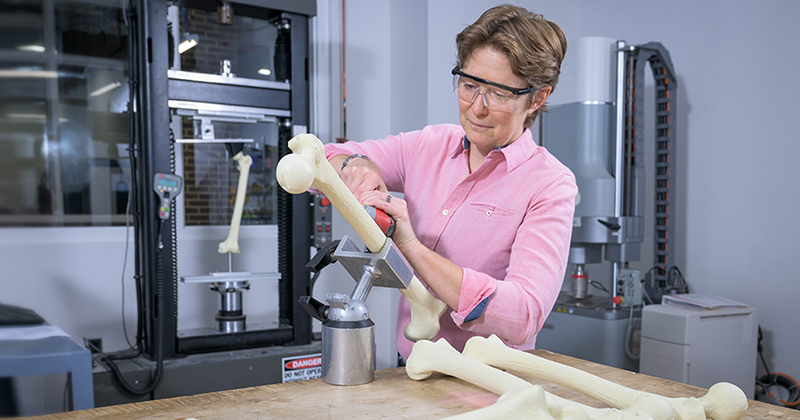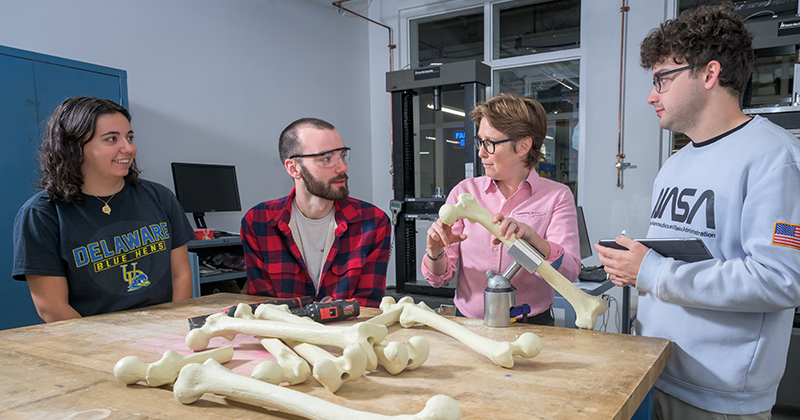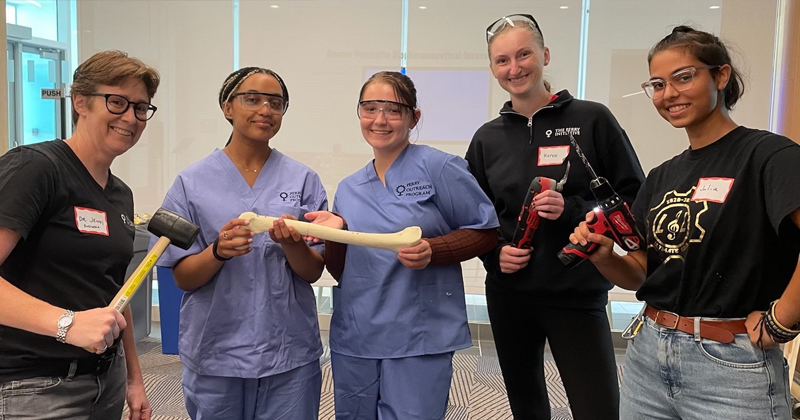


Orthopedics in action
Photos by Evan Krape and courtesy of The Perry Initiative December 01, 2023
UD Engineering’s Jenni Buckley develops orthopedics curriculum for high school students
Orthopedics is one of the least diverse fields of surgical medicine, with individuals identifying as Black or Hispanic making up less than 5% of surgeons and 8.5% who identify as women.
Recognizing the need to increase diversity in the field, The Perry Initiative was founded in 2009 by Jenni Buckley, professor in the College of Engineering’s Department of Mechanical Engineering at the University of Delaware, and Lisa Lattanza, professor and chair of Orthopedics and Rehabilitation at the Yale School of Medicine. For the past 14 years, the nonprofit organization has hosted extracurricular outreach programs targeting students in high school and medical school, and their 17,000 program alumni includes nearly 350 residents and attending surgeons.
Now, the Perry Initiative’s curriculum “Orthopedics In Action®” (OIA) is reaching even more students this fall in classrooms nationwide. Thanks to a partnership with Project Lead The Way (PLTW), a leading pre-K-12 curriculum provider, and Sawbones®, an anatomical models company, OIA has been incorporated as a module in PLTW’s Human Body Systems course and is now available to students in more than 1,500 high school classrooms nationwide.
Grassroots outreach efforts
When Buckley and Lattanza first started The Perry Initiative while the pair were both working at what is now Zuckerberg San Francisco General Hospital, their efforts involved bringing high school students to Buckley’s lab for activities organized by her graduate students. From these humble beginnings, The Perry Initiative grew into a full-fledged nonprofit organization that runs more than 50 programs for approximately 2,000 students in the U.S. every year.
“Lisa and I figured out that a barrier for many students is that they haven't been exposed to orthopedics until they get into medical school. And if they do get exposure to orthopedics, many of them haven’t had any experience with the power tools and the hands-on work,” Buckley said. “Having a safe workshop that teaches them the basics is really helpful for when they are a medical student on rotation.”
Buckley said that in the mid-2010s, The Perry Initiative began getting requests from teachers who wanted to find ways to integrate the hands-on orthopedic activities in the classroom. To come up with a curriculum that was aligned with state and local standards and could easily be completed inside a K-12 classroom, The Perry Initiative sponsored a senior design project in 2015 that was led by UD alumni Ryan Locke, Jeannie Kontos, Emily Pavilonis and Manuela Restrepo-Parra.

Buckley also reached out to UD’s College of Education and Human Development and worked with Amy Trauth, previously the senior associate director of science education in what is now the School Success Center and currently a science education researcher at American Institutes for Research. Thanks to this collaboration, The Perry Initiative was able to develop lesson plans for teachers and pilot the curriculum in classrooms. The end result of this effort was the OIA curriculum, which is currently used in approximately 300 schools nationwide.
Trauth said that the benefit of OIA is that it both teaches the basics of orthopedics while also providing high school students with a broader view of what both doctors and engineers do.
“It shows students that healthcare professionals work with others to solve problems, and engineers are one group of people they work with,” Trauth said. “OIA also shows students how engineers solve problems, and one set of those types of problems are in health care.”
The power of partnership
Thanks to this partnership with PLTW and Sawbones, two of OIA’s lessons will be incorporated directly into the Human Body Systems course in the fall, with the potential to impact nearly 165,000 U.S. high school students across the country. And while the Sawbones models are not required for completing the OIA curriculum, with low-cost alternatives provided as part of the lesson plans, students with access to these anatomical models will be able to do hands-on activities such as diagnosing an ACL tear and solving a “fracture puzzle” on a femur.
“This partnership represents the largest outreach effort in orthopedics history,” Lattanza said. “We understand these early exposures and interventions impact students’ career decisions and open up possibilities that especially diverse students may have thought were otherwise unattainable.”
Buckley said that this partnership feels like a “collective achievement” for everyone who’s been part of The Perry Initiative.

“For me, the biggest gift has been that The Perry Initiative is really what pulled me into teaching and brought me here to Delaware to have this career, which has been so rewarding,” she said.
In addition to the PLTW partnership, The Perry Initiative has been studying the impacts of its outreach efforts. Recently, Buckley was the keynote speaker at the Fall 2023 ASEE Middle Atlantic Section Conference, where she presented data that is also being prepared for publication in a journal.
“We boosted the percentage of women orthopedic surgeons from 14% to 19%, and that trajectory doesn’t even include what we’ll be doing next with Project Lead the Way,” Buckley said about the program’s impact thus far. “When you get involved in diversity work, it’s going to take a while, and that's why I think this case study is so important, because it shows the power of making change at scale.”
A dedication to diversity
In addition to the impact that OIA has already had on increasing the number of women in the field, both Buckley and Trauth are encouraged that this new partnership with PLTW will have an impact on recruiting persons of color to orthopedics in the future.
“While our in-person program participation is at about 18% women of color, we’re really excited about the partnership with PLTW because its demographics are quite diverse,” Buckley said.
“If the students enrolled in those PLTW courses represent the diversity of the communities they're serving, OIA has the propensity to reach a broader diversity in terms of engineering and biomedical professions,” Trauth added. “Experience and exposure are key first steps in the recruitment of a greater diversity among engineers, and these curriculum opportunities make students more aware of what's possible in the discipline.”
When asked about the future of this work, Buckley said that she hopes The Perry Initiative “puts itself out of business” by helping orthopedics become seen as more open and welcoming, a trend she is working toward and hopes to see in other areas of engineering as well.
“You don't get into diversity work for short-term wins — this type of work takes continuous, long-range effort,” Buckley said. “I hope that what we’re doing inspires organizations, showing that if they start to push diversity issues, we can really start to shift the face of the field.”
Contact Us
Have a UDaily story idea?
Contact us at ocm@udel.edu
Members of the press
Contact us at 302-831-NEWS or visit the Media Relations website

